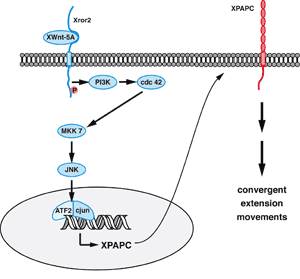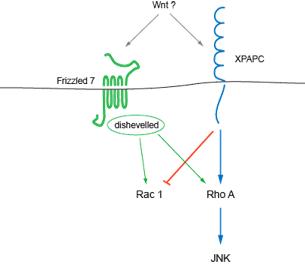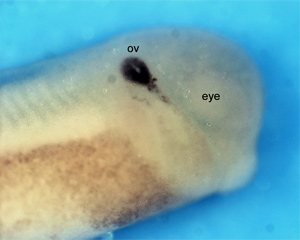Research
Convergent extension movements shape the dorsal anterior-posterior body axis in vertebrates. These movements require strict coordination of cell polarity and migration and include reorganization of the cytoskeleton and modulation of cell-cell adhesion.
Convergent extension movements are controlled by non-canonical Wnt-signaling pathways, predominantly Wnt/PCP signaling and the recently deciphered Wnt-5a/Ror2 pathway. The Wnt-5a/Ror2 target gene XPAPC (Xenopus paraxial protocadherin) is a key molecule that controls cell polarity in gastrulation and functionally interacts with the Wnt/PCP pathway by activating Rho A and JNK.
We are interested in the question, how this network of Wnt signaling pathways controls cell polarity and cell movements.
 |
Fig.1: Wnt-5a/Ror2 signaling in gastrulating Xenopus embryos Publications Schambony, A., Wedlich, D. (2007): Wnt-5A / Ror2 regulate expression of XPAPC through an alternative non-canonical signalling pathway. Dev Cell 12, 779-79 |
Wnt-signaling in gastrulation
The role of canonical and non-canonical Wnt-signaling pathways in the regulation of gastrulation movements has been further emphasized by recent research. The canonical and non-canonical Wnt-pathways regulate cell differentiation, gene expression, cell polarity, –adhesion and -migration. Although some components are believed to act solely in specific branches of Wnt-signaling, an increasing number of effectors are shared by the different pathways and seem to mediate the crosstalk between these branches. In comparative experiments using tissue explants as morphogenetic model system and by detailed studies of cell behavior in time-lapse microscopy we are investigating the roles of Wnts including XWnt-11and XWnt-5A, co-receptors such as LRP5/6 and Ror2, and intracellular scaffolding proteins to elucidate this complex signaling network and its part in regulating gastrulation movements.
 |
Fig.2: Cell polarity and movements in normal convergent extension movements |
Molecular Mechanisms of XPAPC function (PhD thesis Bianca Kraft)
Our previous work suggested that XPAPC and the Wnt/PCP pathway interacted functionally. We currently work on a more detailed characterization of this interaction with respect to the question whether XPAPC has to be considered as part of the Wnt/PCP signaling cascade or if these two pathways correlate in different ways. This work includes further binding studies between XPAPC and XFz7, the identification of additional interaction partners, the mechanism of cytoskeleton modulation by XPAPC and investigating the influence of Wnt/PCP signaling on the subcellular localization of XPAPC.
 |
Fig.3: Interactions between XPAPC and Wnt/PCP signaling |
Otic morphogenesis (PhD thesis Barbara Jung)
It has been shown recently that XPAPC is not only expressed in the paraxial mesoderm but also in the otic vesicle and that it putatively plays a role in otic morphogenesis. Currently our group is establishing the chick embryo as an additional model system for otic development. In this context we also investigate whether the chick homologue of PAPC plays a similar role in otic development as has been described in Xenopus.
 |
Fig.4: Interactions between XPAPC and Wnt/PCP signaling |
Publications
- Schambony, A., Wedlich, D. (2007): Wnt-5A / Ror2 regulate expression of XPAPC through an alternative non-canonical signalling pathway. Dev Cell 12, 779-792
- Bryja, V., Gradl, D., Schambony, A., Arenas, E., Schulte, G. (2007): β-arrestin is a necessary component of Wnt/β-catenin signalling in vitro and in vivo. Proc Natl Acad Sci 104(16), 6690-6695
- Unterseher, F., Hefele, J., Giehl, K., De Robertis, E.M., Wedlich, D., Schambony, A. (2004): Paraxial Protocadherin coordinates cell polarity during convergent extension via Rho A and JNK. EMBO J. 23(18), 3259-69
- Schambony, A., Hefele, J.A., Gentzel, M., Wilm, M., Wedlich, D. (2003): A homologue of cysteine-rich secretory proteins induces premature degradation of vitelline envelopes and hatching of Xenopus laevis embryos. Mech Dev 120(8), 937-48
- Liao, Q., Kleeff, J., Xiao, Y., Guweidhi, A., Schambony, A., Topfer-Petersen, E., Zimmermann, A., Buchler, M.W., Friess, H. (2003): Preferential expression of cystein-rich secretory protein-3 (CRISP-3) in chronic pancreatitis. Histol Histopathol 18(2), 425-33
- Giese, A., Jude, R., Kuiper, H., Raudsepp, T., Piumi, F., Schambony, A., Guerin, G., Crowdhary, B.P., Distl, O., Töpfer-Petersen, E., Leeb, T. (2002): Molecular characterization of the equine testis-specific protein 1 (TPX1) and acidic epididymal glycoprotein 2 (AEG2) genes encoding members of the cysteine-rich secretory protein (CRISP) family. Gene 299, 101-109
- Giese, A., Jude, R., Kuiper, H., Piumi, F., Schambony, A., Guerin, G., Distl, O., Topfer-Petersen, E., and Leeb, T. (2002): Molecular characterization of the equine AEG1 locus. Gene 292, 65-72
- Töpfer-Petersen, E., Gentzel, M., Schambony, A., Reineke, A., Petrounkina, A. (2000): Mammalian CRISP-proteins in fertilisation: Structure-function relationships. Eur. J. Androl
- Schambony, A., Hess, O., Gentzel, M., Töpfer-Petersen, E. (1998): Expression of CRISP-proteins in the equine male genital tract. J. Repr. Fert. Suppl. 53, 67-72
• Schambony, A., Gentzel, M., Wolfes, H., Raida, M., Neumann, U., Töpfer-Petersen, E. (1998): Equine CRISP-3: primary structure and expression in the male genital tract. Biochim. Biophys. Acta 1387, 206-216 - Magdaleno, L., Gasset, M., Varea, J., Schambony, A., Urbanke, C., Raida, M., Töpfer-Petersen, E., and Calvete, J.J. (1997): Biochemical and conformational characterisation of HSP-3, a stallion seminal plasma protein of the cysteine-rich secretory protein (CRISP) family. FEBS Lett. 420, 179-185
Contributions to books and Reviews
- Koehler, A., Schambony, A., Wedlich, D. (2007): Cell migration under control of Wnt signaling in the vertebrate embryo. In Sokol, S.Y. (ed) Wnt Signaling in Embryonic Development, Advances in Developmental Biology, Elsevier, Amsterdam, 159-201
- Schambony, A., Kunz, M., Gradl, D. (2004): Cross-regulation of Wnt-signalling and cell adhesion. Differentiation 72(7), 307-318
- Schambony, A. and Wedlich, D. (2002) Wnt-signaling and cell migration. In Wnt signaling in development. Edited by Kühl M. Georgetown: Landes Biosciences
- Töpfer-Petersen, E., Waberski, D., Hess, O., Bellair, S., Schambony, A., Ekhlasi-Hundrieder, M., Gentzel, M., Reinecke, A. (1998): The role of seminal plasma in fertilisation. Tierärztliche Umschau 7/1998, 447-454
Formerly Staff
- Dr. Martina Schneider
- Dr. Bianca Kraft
- Dr. Barbara Jung
- Dr. Alexandra Schambony: Post Doctoral Scientist (formerly Group leader, now at Uni Erlangen)


